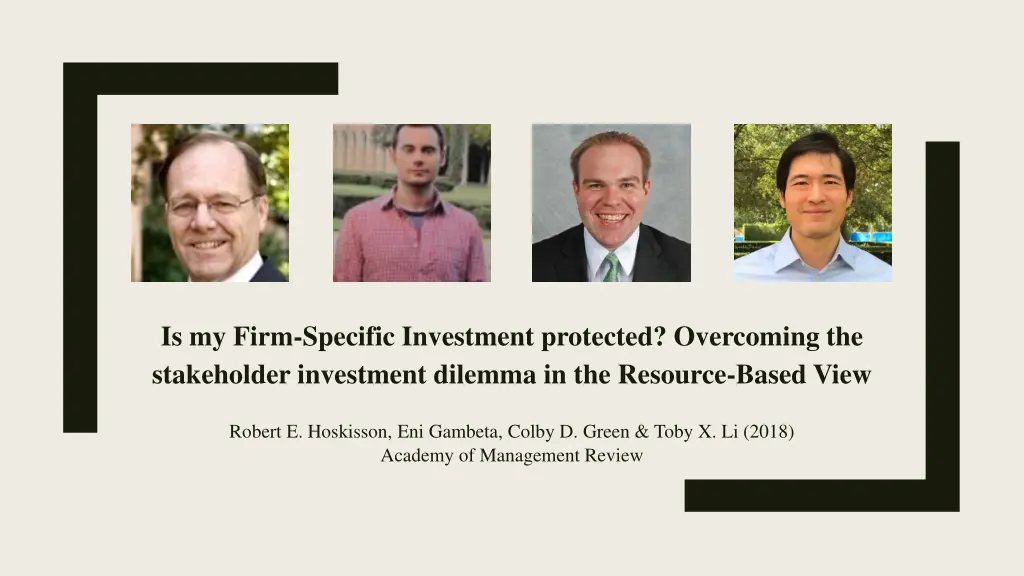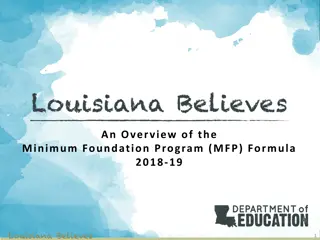
Protecting Firm-Specific Investments: Solutions for Stakeholders
Explore how firm-specific investments (FSIs) can be protected by incentivizing stakeholders through various theoretical lenses such as agency theory and mediating hierarchy perspectives. Discover the challenges, proposed solutions, and models for overcoming the stakeholder investment dilemma.
Download Presentation

Please find below an Image/Link to download the presentation.
The content on the website is provided AS IS for your information and personal use only. It may not be sold, licensed, or shared on other websites without obtaining consent from the author. If you encounter any issues during the download, it is possible that the publisher has removed the file from their server.
You are allowed to download the files provided on this website for personal or commercial use, subject to the condition that they are used lawfully. All files are the property of their respective owners.
The content on the website is provided AS IS for your information and personal use only. It may not be sold, licensed, or shared on other websites without obtaining consent from the author.
E N D
Presentation Transcript
Is my Firm-Specific Investment protected? Overcoming the stakeholder investment dilemma in the Resource-Based View Robert E. Hoskisson, Eni Gambeta, Colby D. Green & Toby X. Li (2018) Academy of Management Review
Introduction Resource based view: a firm achieves sustained competitive advantage through unique bundles of resources that are often created by key stakeholders firm specific investments (FSI). How to incentivize stakeholders to make firm specific investments within the firm? Incentive dilemma (hold-up problem): onceFSI are made, firms can appropriate value and quasi- rents using its bargaining position, while stakeholders cannot obtain value from outside options. Multiple theoretical lenses explore this issue (economics and finance, corporate law, and human capital theories, etc.), proposing a plethora of protection devices to stakeholders.
Theoretical Background Proposed solutions to incentivizing all stakeholders to exert effort in FSIs: Agency theory: ex-ante complete contracts, which allocate ownership and residual claimant rights, to solve ex post holdups. Incomplete contracts theory: since contracts are incomplete, a potential solution would be to assign property (decision) rights to one party. Causal ambiguity internal to the organization implies that none of the actors may know ex-ante what the value of their contribution may be or how it will evolve inefficient property rights allocation. Mediating hierarchy/stakeholder perspective: Assigning decision rights to a mediating hierarchy empowered to protect stakeholder interests and resolve their disputes ex-post.
Theoretical Gap Because of different assumptions or emphasis on a particular stakeholder groups (Clark, 1985), scholars from different fields have generally proposed protection devices in isolation that are only partial solutions to incentivizing stakeholders to make FSIs. This paper: to provide consideration on how prominent devices work together, providing insights on how different devices affect each other in complementary and/or conflicting ways, and how they can help solving the FSI dilemma. Property rights based stakeholder approach: the firm is a nexus of firm specificinvestments from which value appropriation issues stemming from FSIs affect the overall firm value.
Model Development The model is focused on understanding: 1. How individual devices affect each other in complementary and conflicting ways; 2. How they can work in concert to resolve the FSI dilemma for stakeholders. To do so, the authors categorize devices according to the stagein which they function (ex-ante or ex-post) and to two distinct types of uncertainty: Behavioral uncertainty: ex-ante uncertainty about the post-investment behavior of the firm; Environmental uncertainty: ex-ante uncertainty about the value of the investment.
Propositions Ex-ante property rights allocation devices (individual groups): Equity ownership and profit-sharing plans (employees); Joint ventures and long-term contracts (suppliers); Customer property rights (customers). P1: The provision of property rights allocation devices to employee, supplier, and customer stakeholders decreases the hazard associated with ex-ante behavioral uncertainty. Mechanism: reduced firm s opportunism and ability to hold hostage . P2: The provision of property rights allocation devices to employee, supplier, and customer stakeholders increases the hazard associated with ex-ante environmental uncertainty. Mechanism: increased stakeholder risk bearing.
Propositions Ex-ante resource depreciation devices (multiple groups): Diversification; Cost-plus contracting; Takeover protection. P3: The provision of ex-ante resource depreciation devices to [ ] stakeholders decreases their exposure to the hazard associated with environmental uncertainty. Mechanism: firm buffering against environmental uncertainty. P4: The provision of resource depreciation devices to employee, supplier, and customer stakeholders increases the hazard associated with ex-ante behavioral uncertainty. Mechanism: increased power of the firm in comparison to stakeholders.
Propositions Trap: generally, decreasing one type of uncertainty increases the other, so ex-ante devices are insufficient. Ex-post moderating protection devices help firms overcome such a trap by interacting with the ex-ante devices to mitigate the counteractive effects of either type of uncertainty. P5: The provision of ex-post monitoring devices involving BODs [Boards of Directors] and dedicated institutional investors in support of [ ] stakeholders will negatively moderate the effects of the ex-ante devices such that it will reduce the effect of property rights allocation devices on environmental uncertainty. BODs are usually biased towards shareholders. However, when there are independent, dedicated institutional investors, stakeholder FSI causal ambiguity problems are reduced, and the focus remains on the long-term strategic decisions of the firm, favoring stakeholders.
Propositions P6: The provision of ex-post relational governance and trust-based relationship devices to [ ] stakeholders will negatively moderate the effects of the ex-ante devices such that it will reduce the effect of resource depreciation devices on behavioral uncertainty. Mechanism: in pursuing relational governance, the firm and its stakeholders employ informal self- enforcing safeguards to mitigate behavioral uncertainty after contractual conditions are specified. P7: The provision of ex-post relational governance and trust-based relationship devices to employee, supplier, and customer stakeholders provides feedback reducing the importance of ex-ante property rights allocation devices in reducing behavioral uncertainty. Mechanism: increased trust and relational governance decrease behavior uncertainty, thus allowing for more flexible devices that rely on ex-post bargaining.
Conclusions The authors demonstrate the multiple possibilities of complementarities and substitutions among the protection devices, suggesting the need to analyze them in an integrated manner; The framework also suggests that there is not a single solution that is appropriate for all firms. Thus, an idiosyncratic mix of devices depending on firms attributes and contingencies should be preferred; Finally, the degree to which a firm will substitute between alternative devices depends on which type of uncertainty is more salient to stakeholders and on the heterogeneities between those groups; The analysis of distinct combinations of devices under different contingencies presents a good opportunity for future research.






















